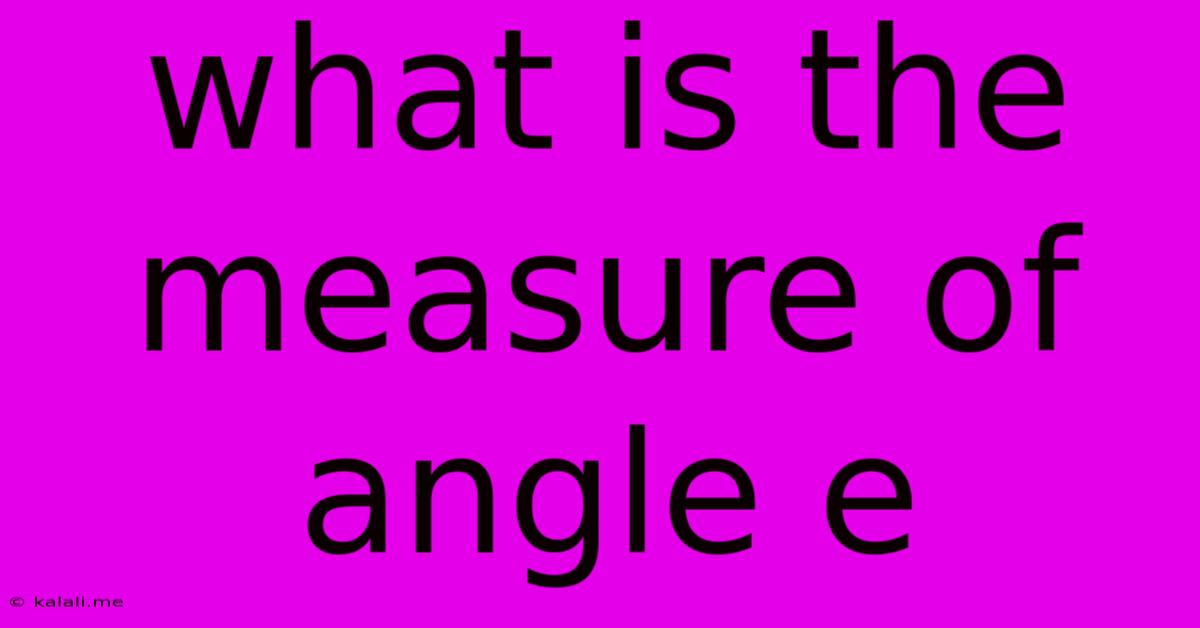What Is The Measure Of Angle E
Kalali
Jun 15, 2025 · 3 min read

Table of Contents
What is the Measure of Angle E? A Comprehensive Guide to Solving for Unknown Angles
Determining the measure of an unknown angle, like angle E, often involves using geometric principles and properties of shapes. This article will guide you through various methods to solve for angle E, depending on the context provided. Understanding the relationships between angles within a given diagram is crucial for accurate calculation. We'll cover several scenarios and provide step-by-step solutions.
Understanding the Context: The Importance of Given Information
Before we can determine the measure of angle E, we need information about the geometrical context in which angle E exists. This could include:
- Type of polygon: Is angle E part of a triangle, quadrilateral, pentagon, or another polygon? Knowing the type of polygon helps determine the sum of interior angles.
- Relationships between angles: Are any angles labeled as supplementary, complementary, vertical, or alternate interior angles? These relationships provide equations to solve for unknowns.
- Parallel lines: Are parallel lines involved? Parallel lines intersected by a transversal create pairs of congruent angles (alternate interior, alternate exterior, corresponding) and supplementary angles (consecutive interior).
- Isosceles or equilateral triangles: If angle E is part of an isosceles or equilateral triangle, we can utilize the properties of equal sides and angles.
Methods for Solving for Angle E
Let's explore several scenarios and the methods used to calculate the measure of angle E:
Scenario 1: Angle E in a Triangle
If angle E is part of a triangle with angles A and B, and we know the measures of angles A and B, we can use the fact that the sum of angles in a triangle is 180 degrees:
- Equation: A + B + E = 180°
- Solution: Subtract the measures of angles A and B from 180° to find the measure of angle E.
Scenario 2: Angle E as a Vertical Angle
If angle E is a vertical angle to another angle (let's call it angle F), then angle E and angle F are congruent (equal in measure).
- Equation: E = F
- Solution: If you know the measure of angle F, then the measure of angle E is the same.
Scenario 3: Angle E as a Supplementary Angle
If angle E is supplementary to another angle (let's call it angle G), then the sum of their measures is 180 degrees.
- Equation: E + G = 180°
- Solution: Subtract the measure of angle G from 180° to find the measure of angle E.
Scenario 4: Angle E in a Polygon
For polygons with more than three sides, the sum of interior angles is calculated using the formula: (n-2) * 180°, where 'n' is the number of sides.
- Example (Pentagon): A pentagon has 5 sides (n=5). The sum of its interior angles is (5-2) * 180° = 540°. If you know the measures of the other four angles, you can subtract their sum from 540° to find the measure of angle E.
Illustrative Example:
Let's say angle E is part of a triangle with angle A measuring 60° and angle B measuring 70°. Using the triangle angle sum property:
60° + 70° + E = 180° 130° + E = 180° E = 180° - 130° E = 50°
Therefore, the measure of angle E is 50°.
Conclusion:
Finding the measure of angle E requires careful examination of the given diagram and the relationships between angles. Utilizing the properties of triangles, polygons, parallel lines, and angle relationships (supplementary, complementary, vertical) are essential for accurate calculations. Remember to clearly define the context and apply the appropriate geometric principles to solve for the unknown angle.
Latest Posts
Latest Posts
-
What Is The Output Of The Following Code
Jun 15, 2025
-
A Word That Connects Words Phrases And Clauses
Jun 15, 2025
-
What Connects The Piston To The Crankshaft
Jun 15, 2025
-
Which Range Of Mountains Separates France From Spain
Jun 15, 2025
-
A Similarity Between E Commerce And Traditional Commerce Is That Both
Jun 15, 2025
Related Post
Thank you for visiting our website which covers about What Is The Measure Of Angle E . We hope the information provided has been useful to you. Feel free to contact us if you have any questions or need further assistance. See you next time and don't miss to bookmark.